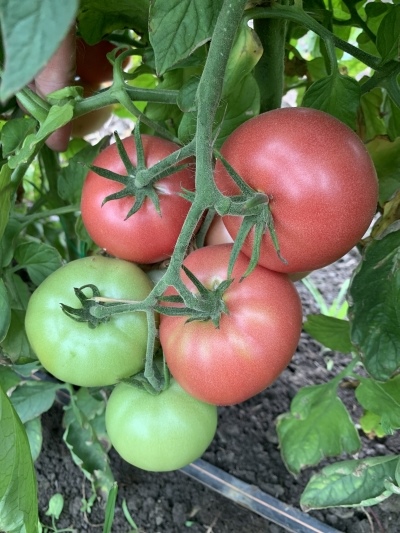
- Authors: Mashtakov A. A., Mashtakova A. Kh., Ignatova S. I., Mashtakov N. A., Mashtakova L. I.
- Year of approval: 2007
- Name synonyms: Boogie Woogie F1
- Category: hybrid
- Growth type: indeterminate
- Appointment: fresh consumption
- Ripening period: early
- Ripening time, days: 103
- Growing conditions: for open ground, for film greenhouses, for greenhouses
- Marketability: excellent
The Boogie Woogie tomato is able to supply farmers and summer residents with high quality fruits. But for this you need to think over a strategy for handling it. This is why it is so important to study as much of the available information as possible.
Breeding history
The Boogie Woogie variety was introduced to the general public in 2007. Therefore, it is one of the relatively new plants, which, at the same time, have already managed to recommend themselves well. A group of five breeders led the work on the crop. This is a brilliant product of domestic crop production, completely adapted from the very beginning for cultivation in Russia.
Description of the variety
Boogie Woogie is one of the indeterminate hybrids. Its official description mentions the suitability for open ground and for various greenhouses (both conventional and with foil). And also there is a high marketability of the crop. Boogie Woogie bushes grow up to 1.3 m. The number of leaves is moderately large, and the foliage itself also has an average size, painted in a simple green color.
The main qualities of the fruit
Unripe Boogie Woogie berries are distinguished by their green color. When they are ripe, they will turn pink and will not have the characteristic green spot around the stalk. The mass of a single tomato can reach 250 g. There are 5 to 7 tomatoes per brush. These large fruits are distinguished by the so-called flat-round shape.
Taste characteristics
Boogie Woogie tastes little different from other tomatoes. Tasters also note the firmness of its pulp. Therefore, it is possible to grow this culture for personal needs without any hesitation. There will be no problems on a large plantation. The proportion of sugar is 3% of the pulp.
Ripening and fruiting
Boogie Woogie belongs to the usual early group. The fruits will ripen in an average of 103 days. They are collected in brushes of 3-5 pieces. Even if you pick green tomatoes, they will ripen under normal room conditions.
Yield
Boogie Woogie is a highly fertile tomato. The harvest for 1 plant can reach 10 kg. In terms of 1 m2, this will already be 18.7 kg.
The timing of planting seedlings and planting in the ground
It is necessary to plant seeds as early as possible. If possible - no later than February 15th. A tomato should be transplanted to a permanent cultivation place in a greenhouse in the last decade of April or at the very beginning of May. It is this approach that guarantees an excellent result and the disclosure of the potential of the variety.

Growing tomato seedlings is an extremely important process, because it largely depends on whether the gardener will be able to harvest at all. All aspects must be taken into account, from seedbed preparation to planting in the ground.
Landing scheme
It is recommended to choose the placement of bushes according to the rule of 700x400 mm. The optimal planting density is 3 tomatoes per 1 m2. When forming, leave 1 or 2 stems.The row spacing must be at least 0.6 m.

Growing and care
The culture is optimal for seedling cultivation. Seeds should be sown with minimal burial. The dive of seedlings is carried out after the formation of 2-3 true leaves. After planting in open ground on the first night, it is necessary to protect the plants with foil at night. Immediately after watering, the soil must be loosened.
During the growing season, you need to feed the tomato 3 or 4 times. For this, a complete complex fertilizer is used, periodically changing to organic matter. The stems that have grown high will need to be tied to supports. The lateral processes are removed above the 3rd hand.




A plant needs different micronutrients at each stage of growth. All fertilizers can be divided into two groups: mineral and organic. Folk remedies are often used: iodine, yeast, bird droppings, eggshells.
It is important to observe the rate and period of feeding. This also applies to folk remedies and organic fertilizers.
Disease and pest resistance
Insect pests specific to this particular variety have not been described. In case of damage, either industrial insecticides or self-prepared herbal infusions are used. The Boogie Woogie tomato fights well:
cracking;
top rot;
defeat by septoria;
tobacco mosaic virus;
fusarium wilting.


Resistant to adverse weather conditions
The variety is resistant to high temperatures. The plant is able to thrive even in the shade. Seedlings must be kept at a temperature of exactly +25 degrees until shoots form. It must be hardened at + 16 ... 18 degrees. Further, before planting in the garden, the seedlings should be kept at a temperature of + 20 ... 22 degrees.
Growing regions
The plant is zoned into:
Northwest;
North;
central regions of the European part;
Central Black Earth Region;
Volgo-Vyatka region;
various regions of the North Caucasus and the Middle Volga region.

























































































